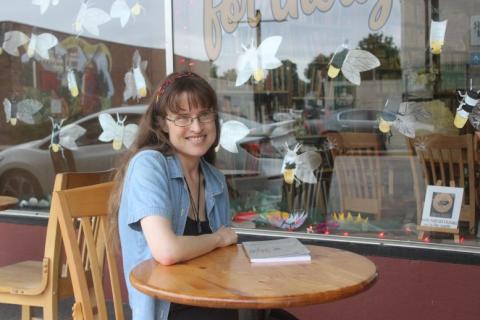
by Laura I. Miller
[caption id="attachment_6753" align="alignright" width="160"] Teresa Milbrodt[/caption]
Teresa Milbrodt[/caption]
I knew I had come across something special when I first encountered Teresa Milbrodt’s short story “Bianca’s Body” several years ago. In this story, as with the others in her collection Bearded Women, uncanny circumstances illuminate the strangeness of domestic concerns that we all face. Her portrayal of powerful women with depth who defy the status quo has, in my mind, cemented her among great contemporary fabulists like Karen Russell, Aimee Bender, and Kelly Link. Her latest, a novel composed of flash fiction titled Larissa Takes Flight, challenges conventional notions of genre and traditional representations of time. Instead of following her protagonist Larissa’s linear progression, Milbrodt offers short snippets from her life, including “Larissa and the Snake” and “Larissa Buys Work Pants,” that accumulate into a mosaic of Larissa’s particular struggles. I love this format, which is especially suited to the character’s often-manic state of being, and spoke with Milbrodt about her method and influences for this novel, which just received The Whirling Prize for fiction.
Teresa Milbrodt is the author of three books, and her stories have appeared in PANK, Guernica, TriQuarterly, Booth, Nimrod, North American Review, Indiana Review, Hayden's Ferry Review, and New Orleans Review, among others. Several of her stories have also been nominated for a Pushcart Prize. For links to stories and reviews, visit teresamilbrodt.com.
How did you conceive of Larissa Takes Flight initially?
Perhaps because I started my literary career as a short story writer, my novels have generally begun with a story and a character I liked and knew had a longer arc. Larissa Takes Flight began with three short pieces that I wrote specifically to be performed. After those first stories my protagonist still had more to say, so her musings and adventures developed into a collection of stories that I eventually shaped into an arc, similar to Sandra Cisneros' book The House on Mango Street. Both books are composed of flash fiction pieces focused on a particular person and place.
Larissa Takes Flight doesn’t have a traditional, linear plot, though there’s definitely forward momentum. How did you envision time operating in the novel?
Like The House on Mango Street, I didn't see this book as having a set time period, it's more about a series of events in this character's life. She gains and loses jobs, goes through I'm not sure how many boyfriends before settling on one she likes, and is trying to be a decent person and keep her halo on straight no matter what evil co-workers or time doing jury duty might stand in her way. Similar to a photo album I think you can see her growth from snapshot to snapshot, even though the exact amount of time that has passed from the beginning to the end of the book isn't as important as in a traditional novel.
How would you classify Larissa Takes Flight in terms of genre? Which writers influence your style?
Some of the pieces are more comic and realistic, but others fall into slipstream or speculative fiction. That was one of the reasons I particularly liked this character and was drawn to her, since anything can (and does) happen in her world. Since these stories are primarily flash fiction, it's also a good place to play with the odd little ideas and tangents that couldn't be expanded into a fifteen-page story, but make a fun and quirky piece of flash fiction. In terms of my influences, I particularly enjoy George Saunders, Sherman Alexie, and Gabriel Garcia Marquez.
Larissa often speaks in long, compound sentences. How were you able to maintain her voice and sense of urgency throughout the novel?
While writing these stories, I tried to keep in mind that I wanted them to work on the page as well as when read aloud. Because I was composing these pieces with performance in the back of my mind, Larissa tends to speak in long train-of-thought sentences. Also, since I was writing these stories in short bursts, composing five or six at a time and focusing on particular topics, I think that made it easier to sustain her energetic tone.
How did you know when the book was finished?
When Larissa didn't seem like she had that much more to say, I stopped. She's since resumed talking, so I'm working on a second book.
What can potential students expect from your upcoming Online Intro to Writing the Novel Workshop with Lighthouse?
This upcoming workshop is meant for anyone who wants an occasion, excuse, or self-imposed obligation to work on a novel (or novel-in-stories) project. It can be an idea you've been mulling forever but haven't taken time to develop, a project for which you have a few scattered notes, or a book you've drafted in whole or part and want to dig out, rework, and receive feedback. It's a great opportunity to be in a class with others who are working in the long form.
Teresa will be teaching 8-Week: Online Intro to Writing the Novel and 8-Week Online Intro to Creative Nonfiction starting March 30. Stay tuned here for more lightning interviews with instructors joining us this spring!
Laura is Lighthouse’s Program Assistant. She holds an MFA in fiction from the University of Arizona where she served as co-editor-in-chief of Sonora Review and managing editor of Fairy Tale Review. She also teaches occasional workshops at Denver Writes and contributes to the Books section of Bustle.

